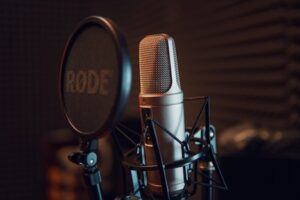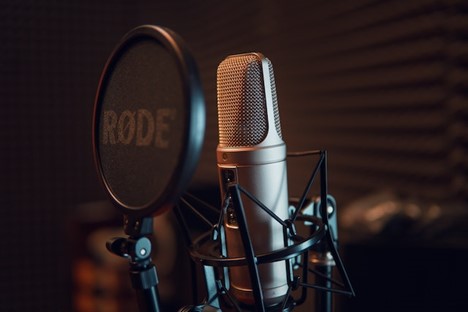
A recent survey from the Audio Publishers Association and InterQ found that audiobook revenue rose to $1.6 billion in 2021 — a 25% annual increase. This suggests that more people are tuning into audiobooks as a form of entertainment or enrichment. While audiobooks do provide a more convenient reading experience, they aren’t the easiest to produce. Audiobook narrators spend hours recording in a booth, with the goal of sounding vocally stable and consistent throughout the book.
Audiobook narrators also require multiple takes. As discussed in our post on “5 Essential Tips for Recording an Audiobook”, reading a 300-page novel out loud will take a lot of time and effort. Even professional voice actors make mistakes; you must pick back up from the start of the line or paragraph every time an error is made.
Needless to say, recording an audiobook narration is time-consuming and difficult. As much as possible, you should opt to visit a pro recording studio like ours to have your audiobook narrations done in a professional setting and for guaranteed optimal results. That doesn’t mean it’s totally impossible to try and record your audiobook yourself. Everyone has to start somewhere, after all.
If you’re still looking to try recording a high-quality audiobook yourself, this guide will help you with the five essential components of audiobook recording equipment:
Recording space
Before everything else, you must ensure a decent recording space. This can be a room in your house or at your office. A vital aspect of any recording space is to have it soundproofed so that your recording doesn’t feature unwanted background sounds and noises, such as cars passing by outside or a door opening or closing somewhere else in the building.
The New York Times guide to DIY soundproofing includes tips such as adding foam squares to windows to block out sound, as well as hanging heavy blankets on the wall to absorb vibrations. You can also look for specialized blankets made for sound absorption. Another tip for soundproofing your recording space is adding an extra layer of hardwood flooring if your house has a creaking problem. You can also wallpaper your recording room with a millimeter of cork product to help with soundproofing.
Microphones
Most, if not all, high-quality audiobook recordings use professional microphones to capture the best sound. Shout4Music’s guide to the best recording mics highlights how most professional audiobook recordings require a consistent sound recording so that readers — or listeners — don’t get disoriented by changes in voice quality. This can be achieved using large-diaphragm condenser microphones.
Most large-diaphragm condenser mics, such as the sE Electronics sE2300, provide a crystal-clear sound that enhances vocal clarity. The sE2300 is a popular mic for home and professional recording studios, as it is deemed one of the best microphones for recording. Another go-to is the classic Neumann U87 — a large-diaphragm condenser that fits a broad range of general purposes, from studio to film and television. Most pro recording studios (like ours) use the U87 as it offers a balanced frequency response that highlights speech and vocals. Condenser microphones specialize in picking up delicate and detailed sounds, so they’re ideal for capturing nuances in an audiobook narration performance.

Headphones
You’ll also need a decent pair of headphones to monitor your recorded files and ensure no mistakes or unwanted noises are recorded. For this, you should look for headphones that feature sound isolation. Sound isolation lets you hear how an audio track actually sounds without any echoes that may have been picked up during the recording process.
Forbes’ feature on the Beyerdynamic DT 700 Pro X highlights how the headphones offer excellent sound isolation, making it an ideal pair for recording, as well as broadcasting and live-streaming. Aside from providing high-quality playback, the DT 700 Pro X also features velour ear pads that make them comfortable for long periods of use — such as recording an audiobook.
Digital audio workstation
Digital audio workstations (DAW) are computer software that let you record, edit, and produce audio files. If you’re recording your audiobook without an audiobook engineer, you’ll need a DAW to handle each process step, from recording and editing to finishing up your audiobook production.
Software such as Audacity, Twisted Wave, and Reaper are great for the sole purpose of audiobook recording and editing. Most DAWs will also allow plugins to help you edit and polish your audiobooks, such as de-noisers and enhancements that benefit your audiobook’s overall vocal clarity or sound quality.
Reading device
Lastly, a key component of your recording sessions is a digital reading device — not the printed paperback or hardcover book. This is because you don’t want to record page-flipping sounds. For seamless recording, a digital reader that uses your finger on a touchscreen will be much more silent.
Common reading devices include the Kindle or tablet devices such as the iPad. You can also use your computer or laptop as a reading device if you don’t use loud keyboards or mice to “flip” your pages. You can also use your smartphone to record your audiobook if you’re on a budget. Just be careful when reading from a much smaller screen so you don’t misread or make any mistakes mid-recording.
While DIY recording can be a fun and fulfilling project to embark on, working with a full-service recording studio can ensure your audiobook quality will be clear and crisp for your readers. At Live Oak Studio, our state-of-the-art equipment and professional engineers can produce satisfying results. Contact us today to learn more about how we can serve you.
By Terra Gareth
